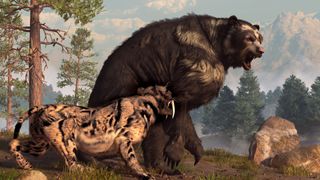
With ecosystems as varied as oceans, plains and frozen tundras, North America is home to some giant and ferocious predators. But these modern creatures — including alligators, great white sharks and polar bears — look minuscule next to the continent’s slew of ancient predators. So, what are the largest predators that have ever lived in North America?
As for furry animals, North America’s largest predatory mammal was probably the massive short-faced bear (Arctodus simus), said Ross MacPhee, senior curator of mammals at the American Museum of Natural History in New York City. Sometimes affectionately called the “bulldog bear,” this now-extinct creature had a signature short, broad muzzle. It stood around 5.5 feet (1.6 meters) tall at the shoulder and over 11 feet (3.4 m) on its lanky hind legs, according to the University of Iowa Museum of Natural History.
It can be difficult for scientists to gauge the exact body weight of an extinct species, because they have to extrapolate those numbers using existing species as benchmarks, MacPhee told Live Science in an email. However, paleontologists comfortably estimate that the short-faced bear probably weighed around 1,540 pounds (700 kilograms). Modern polar bears (Ursus maritimus) aren’t too far off — the largest males stand around 5 feet (1.5 m) at the shoulder and weigh around 1,300 pounds (600 kg), according to Polar Bears International.
Related: Why do animals hibernate?
Short-faced bears went extinct about 11,000 years ago, around the end of the last ice age. To find a more massive land predator, we’ll have to travel further back in time. The largest predatory North American dinosaur is also the continent’s most famous: the king, Tyrannosaurus rex.
During the late Cretaceous period, about 100 million to 66 million years ago, North America was a land of monsters. “Carnivorous dinosaurs had incredible variety in North America across the Mesozoic ,” Andrew Farke, director of the Raymond M. Alf Museum of Paleontology in Claremont, California, told Live Science in an email. There was the spiny-backed Acrocanthosaurus, the sharp-clawed Deinonychus, and the slender, feathery Microvenator.

But at nearly 12 feet (3.5 m) tall at the hips and up to 40 feet (12.3 m) long, according to a nearly-complete, school bus-size T. rex specimen known as Stan, the terrible tyrant rex towered over most of its carnivorous contemporaries. Acrocanthosaurus, a “shark-toothed” cousin of tyrannosaurs and member of a group known as carcharodontosaurs, nearly matched T. rex‘s length but was lighter, weighing 6.8 tons (6.1 metric tons), compared with T. rex’s 7.8 tons (7.1 metric tons), according to the American Museum of Natural History. T. rex used all that bulk to its advantage: With its powerful jaw muscles, it could deliver up to 6 tons (5.4 metric tons) of pressure per bite — enough to tear through steel as if it were a piece of paper, according to a 2019 study in the journal The Anatomical Record.
The only dinosaurs alive today are birds, making the largest living dinosaur in North America the California condor (Gymnogyps californianus). At 10 feet (3 m) from wing tip to wing tip, this bird is significantly smaller than its ancient meat-eating cousin T. rex, but formidable in its own right, feeding on the carcasses of deer, pigs, cattle, sea lions and even whales, according to the Cornell Lab of Ornithology.

When it comes to ancient sea behemoths, a giant reptile takes the cake. Ichthyosaurs were a group of predatory marine reptiles that lived during the Mesozoic era, the same time period as the dinosaurs. In the late Triassic period, roughly 237 million years ago, an ichthyosaur known as Shonisaurus sikanniensis began swimming in the waters of what is now British Columbia, Canada.
“S. sikanniensis is regarded as the largest known marine reptile of all time,” Kenshu Shimada, a professor of paleobiology at DePaul University in Chicago, told Live Science. There is some debate about which ichthyosaur genus S. sikanniensis belonged to: Shastasaurus or Shonisaurus. Members of both genera were large, streamlined and speedy, though species of the Shonisaurus genus had barrel-shaped chests and long snouts compared with the slender, shorter-snouted Shastasaurus, according to University of Portsmouth paleontologist and paleoartist Mark Witton.
Regardless of taxonomy, there is no question that S. sikanniensis was absolutely colossal; it measured an astonishing 65 feet (20 m) long from snout to tail, “easily about three times longer than the largest known living great white shark,” Shimada said. But size doesn’t always equal ferocity. A 2011 study in the journal PLOS One suggested that S. sikanniensis may have been a suction feeder, slurping up soft-bodied prey such as squids and belemnites (shelled squids).
Each of these creatures, however, eventually died out as the result of environmental upheaval. Like many highly specialized predators, once their prey became scarce, they simply couldn’t keep up with their energy needs. “At a certain point, bigger is not better,” MacPhee said.
Originally published on Live Science.

Joanna Thompson is an intern for Live Science with a deep love for nature. She holds a B.S. in zoology and a B.A. in creative writing from North Carolina State University, and will complete her Master’s degree from New York University’s Science, Health and Environmental Reporting Program in December 2021. Her work has appeared in Scientific American, Atlas Obscura, Audubon and In These Times.
Note: This article have been indexed to our site. We do not claim legitimacy, ownership or copyright of any of the content above. To see the article at original source Click Here

.jpg)











